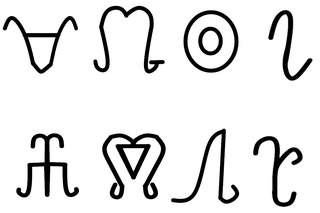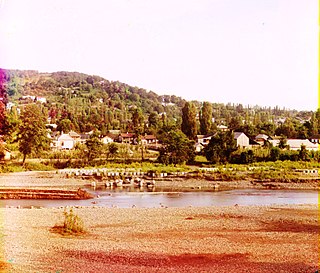Related Research Articles

Circassia or Zichia was a country and a historical region in the North Caucasus along the northeast shore of the Black Sea. It was conquered and occupied by Russia during the Russian-Circassian War (1763–1864), after which 90% of the Circassian people were either exiled from the region or massacred in the Circassian genocide.

The Circassians are an indigenous Northwest Caucasian ethnic group and nation native to the historical country-region of Circassia in the North Caucasus. As a consequence of the Circassian genocide, which was perpetrated by the Russian Empire in the 19th century during the Russo-Circassian War, most Circassians were exiled from their homeland in Circassia to modern-day Turkey and the rest of the Middle East, where the majority of them are concentrated today. The Unrepresented Nations and Peoples Organization estimated in the early 1990s that there are as many as 3.7 million Circassians in diaspora in over 50 countries.

Adyghe, also known as West Circassian, is a Northwest Caucasian language spoken by the western subgroups of Circassians. It is spoken mainly in Russia, as well as in Turkey, Jordan, Syria and Israel, where Circassians settled after the Circassian genocide. It is closely related to the Kabardian language, though some reject the distinction between the two languages in favor of both being dialects of a unitary Circassian language.

The Kabardians or Kabardinians are one of the twelve major Circassian tribes, representing one of the twelve stars on the green-and-gold Circassian flag. They are also commonly known by the plural terms Kabardin, Kebertei, or Kabarday. Along with the Besleney tribe, they speak a distinctive dialect of the Adyghe language. Historically the Kabardians lived in Kabardia, a region of the north Caucasus. In modern times the Kabardians live mostly in the Russian republic of Kabardino-Balkaria, which partly corresponds to the historic region.

The Hatuqway are one of the twelve major Circassian tribes, representing one of the twelve stars on the green-and-gold Circassian flag. They were known for their art of war as a warrior tribe. After the Russo-Circassian War, their presence in the Caucasus was destroyed during the Circassian genocide, and their number was significantly decreased and today they exist only in small communities in various diasporas, and their names are not mentioned anymore in Circassian dialectology.

The Shapsug are one of the twelve major Circassian tribes. Historically, the Shapsug tribe comprised one of the largest groups of the Black Sea Adyghe. They inhabited the region between the Dzhubga River and the Shakhe Rivers and high-altitude mountainous areas of the northern slopes of the Caucasus range along the Antkhir, Abin, Afips, Bakan, Ships, and other rivers . In Russia, the remaining Shapsug population mainly live in the Tuapsinsky District (Tuapse) of Krasnodar Krai, Lazarevsky City District of Sochi, and in the Republic of Adygea, which were a small part of historical Circassia.

The Abzakh are one of the twelve major Circassian tribes, representing one of the twelve stars on the green-and-gold Circassian flag. Historically, they lived in the mountainous part of the modern Russian republics of Adygea and Krasnodar Krai. Major settlements or villages were located in the river valleys Kurdzhips, Psheha, Pshish, and Psekups.
The Sittaceni were an ancient people dwelling along the Palus Maeotis in antiquity. Strabo describes them as living among the Maeotae, Sindi, Dandarii, Toreatae, Agri, Arrechi, Tarpetes, Obidiaceni, Dosci, and Aspurgiani, among others. Sittaceni is one of the Maeotae tribes, who lived in the 1st millennium BC on the east and the south-eastern coast of the Azov sea. In the Great Soviet Encyclopedia, they were concluded to have been one of the ancestors to the Circassians. In the 4th–3rd centuries BC many of the Maeotae tribes were included into the Bosporan Kingdom.

The Maeotians were an ancient people dwelling along the Sea of Azov, which was known in antiquity as the "Maeotian marshes" or "Lake Maeotis". They are often considered to be the ancestors of the Circassians, Abkhazians, and Abazins.
The Dandarii or Dandaridae were an ancient people dwelling along the Palus Maeotis in antiquity. Strabo describes them as living among the Maeotae, Sindi, Toreatae, Agri, Arrechi, Tarpetes, Obidiaceni, Sittaceni, Dosci, and Aspurgiani, among others. The Dandarii were one of the Maeotae tribes, who lived in the 1st millennium BC on the east and the south-eastern coast of the Azov sea. In the Great Soviet Encyclopedia, they were concluded to have been one of the ancestors to the Circassians. Maeotae were engaged in farming and fishing. In the 4th–3rd centuries BC many of the Maeotae tribes were included into the Bosporan Kingdom.
The Toreatae or Toretae were a tribe of the Maeotae in Asiatic Sarmatia. Strabo describes them as living among the Maeotae, Sindi, Dandarii, Agri, Arrechi, Tarpetes, Obidiaceni, Sittaceni, Dosci, and Aspurgiani, among others.
The Arrechi were an ancient tribe of the Maeotae, on the east coast of the Palus Maeotis. Strabo places them among the Maeotae, Sindi, Dandarii, Toreatae, Agri, Tarpetes, Obidiaceni, Sittaceni, Dosci, and Aspurgiani, among others.
The Obidiaceni were an ancient people dwelling along the Palus Maeotis in antiquity. Strabo describes them as living among the Maeotae, Sindi, Dandarii, Toreatae, Agri, Arrechi, Tarpetes, Sittaceni, Dosci, and Aspurgiani, among others.
The Dosci (Doschi) - were an ancient people dwelling along the Palus Maeotis in antiquity.
Circassian music refers to the traditional songs and instruments of the Circassians.

The Natukhaj, Natuqwai or Natukhai are one of the twelve major Circassian tribes, representing one of the twelve stars on the green-and-gold Circassian flag. Their areas historically extended along the Black Sea coast from Anapa in the north to Tsemes Bay in the south and from the north side of the mountains to the lower Kuban River.

The area of the Russian city of Sochi was populated more than 100,000 years by ancient people of Asia Minor migrating through Colchis. Ancient Greeks sailed to the region via the Black Sea in the 5th–6th centuries BC and encountered the Maeotae, Sindi, Cercetae, Zygii and other local tribes. They were the ancestors of the Abkhaz, Ubykh and Adyghe people who lived here until 1864; many toponyms in Sochi, including the city itself, originate from their languages. The first Russian outpost was set up in central Sochi in 1838 as a part of the Russian expansion along the Black Sea coast. The local resistance to this process became a part of the Russo-Circassian War which ended in a Russian victory and the genocide of the local population. The Russian settlement built in the area was named Sochi in 1896 and received the status of a city (town) in 1917. The first tea plantations were established there in 1901–1905 and resulted in the production of the most prominent brand of Russian tea. From the end of the 19th century, the city has been developed as a dedicated area for sanatoriums and hospitals. It served as a rehabilitation center during World War II and, despite a decline following the dissolution of the Soviet Union, remains the major resort town of Russia. An important recent event was selection of Sochi as the site of the 2014 Winter Olympics and 2014 Winter Paralympics.

The Adyghe Xabze or Circassian Xabze is the worldview and moral code of the Circassian people. Circassian society dictates that a Circassian must always live according to rules defined by the Xabze with little exceptions. Tenets of Xabze include special respect for elders and women, a policy of only marrying those from Circassian culture to protect the endangered culture, and the values of truthfulness, honor and bravery. While rooted in thousands of years of tradition, Xabze is evolving and ever-changing, and is reformed to fit the needs of the Circassian community, usually led by a Thamade.
The Khatuq or Adale were a Circassian tribe that lived on the Taman Peninsula until it was occupied by Russian troops during the Russo-Circassian War, following which, the tribe was annihilated in the Circassian genocide.
The Chebsin or Tsopsin were a Circassian tribe. They were destroyed in the Circassian genocide following the Russo-Circassian War.